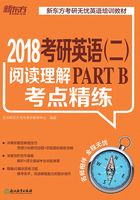
Passage 3
Directions: Read the following text and answer the questions by choosing the most suitable subtitle from the list A–G for each numbered paragraph (1~5).There are two extra subtitles which you do not need to use.Mark your answers on the ANSWER SHEET.(10 points)
[A] Time and money costs in transporting children
[B] Transporting children weakens the sense of local community
[C] Benefits of children's independent access to their local streets
[D] More mobility of people given by cars
[E] Measures taken by the government
[F] Transporting children leads to a more dangerous environment
[G] Traffic and environmental problems caused by transporting children
The private car is assumed to have widened our horizons and increased our mobility.When we consider our children's mobility,they can be driven to more places (and more distant places) than they could visit without access to a motor vehicle.However,allowing our cities to be dominated by cars has progressively eroded children's independent mobility.Children have lost much of their freedom to explore their own neighborhood or city without adult supervision.In recent surveys,when parents in some cities were asked about their own childhood experiences,the majority remembered having more,or far more,opportunities for going out on their own,compared with their own children today.They had more freedom to explore their own environment.
1.______
Children's independent access to their local streets may be important for their own personal,mental and psychological development.Allowing them to get to know their own neighborhood and community gives them a “sense of place”.This depends on active exploration,which is not provided for when children are passengers in cars.(Such children may see more,but they learn less.) Not only is it important that children be able to get to local play areas by themselves,but walking and cycling journeys to school and to other destinations provide genuine play activities in themselves.
2.______
There are very significant time and money costs for parents associated with transporting their children to school,sport and to other locations.Research in the United Kingdom estimated that this cost,in 1990,was between 10 billion and 20 billion pounds.
3.______
The reduction in children's freedom may also contribute to a weakening of the sense of local community.As fewer children and adults use the streets as pedestrians,these streets become less sociable places.There is less opportunity for children and adults to have the spontaneous exchanges that help to engender a feeling of community.This in itself may exacerbate fear associated with assault and molestation of children,because there are fewer adults available who know their neighbors'children,and who can look out for their safety.
4.______
The extra traffic involved in transporting children results in increased traffic congestion,pollution and accident risk.As our roads become more dangerous,more parents drive their children to more places,thus contributing to increased levels of danger for the remaining pedestrians.Anyone who has experienced either the reduced volume of traffic jams near schools at the end of a school day will not need convincing about these points.Thus,there are also important environmental implications of children's loss of freedom.
5.______
As individuals,parents strive to provide the best upbringing they can for their children.
However,in doing so,(e.g.by driving their children to sport,school or recreation) parents may be contributing to a more dangerous environment for children generally.The idea that “streets are for cars and backyards and playgrounds are for children”is a strongly held belief,and parents have little choice as individuals but to keep their children off the streets if they want to protect their safety.
词汇注释
erode v.侵蚀,腐蚀
pedestrian n.行人,步行者
spontaneous a.自发的;无意识的
engender v.产生,造成
exacerbate v.使加剧;恶化;激怒
assault n.突击,袭击
molestation n.骚扰,干扰;调戏
congestion n.堵塞